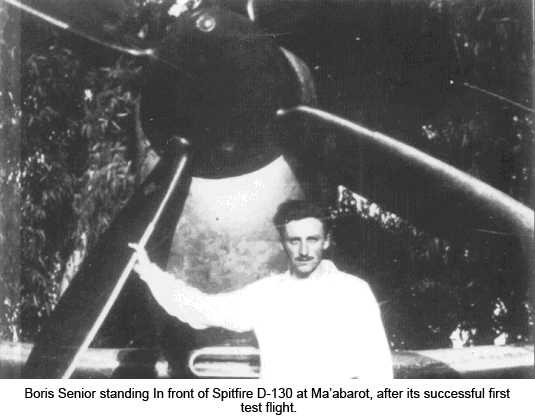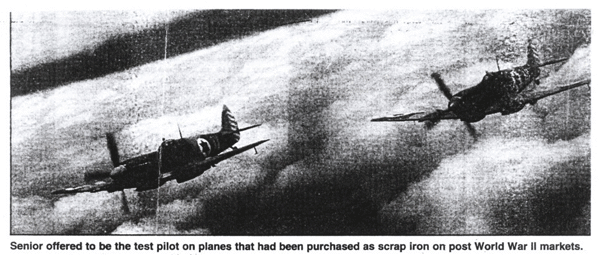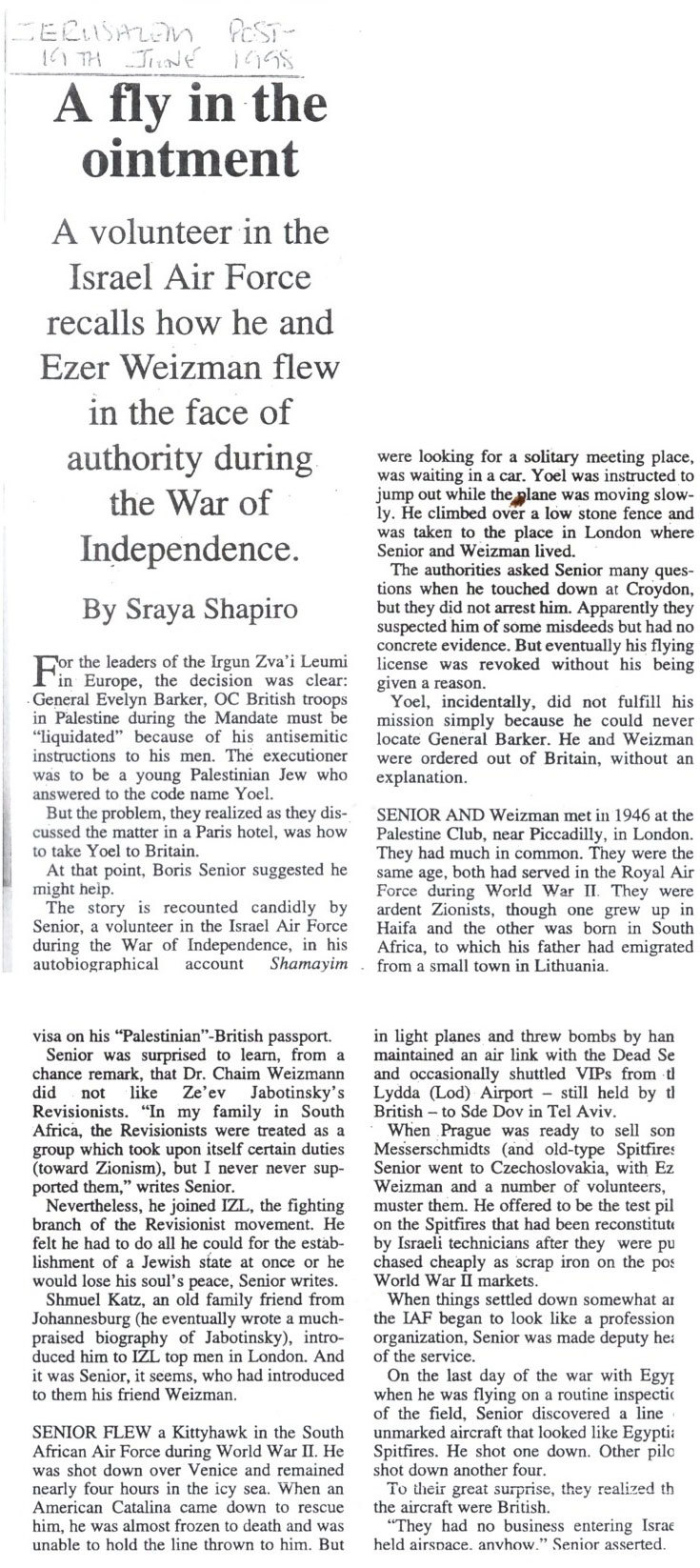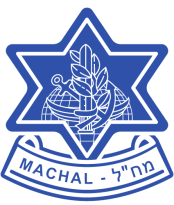COMMANDER OF SDE DOV AIRBASE (TEL AVIV),
AND PILOT IN 101 SQUADRON
 Boris Senior, the son of a most ardent South African Zionist family, was an exceedingly adventurous, enterprising and courageous man. His older brother Leon, a pilot in the South African Air Force in World War II, was killed in action.
Boris Senior, the son of a most ardent South African Zionist family, was an exceedingly adventurous, enterprising and courageous man. His older brother Leon, a pilot in the South African Air Force in World War II, was killed in action.
Boris, too, was a fighter pilot in the South African Air Force in World War II. Having been shot down over Italy, he bailed out and landed in the icy waters of the Adriatic Sea, and was heroically rescued by the crew of a U.S. Air Force Catalina flying boat.
In 1947, whilst studying economics at London University, Boris became friendly with a fellow student, Ezer Weizman, and both of them became involved in the activities of the Irgun Zvai Leumi underground. On becoming a suspect of Scotland Yard, Boris returned to South Africa.
The U.N. Resolution of November 1947 on the partition of Palestine was a turning point in Boris’ life. He immediately boarded a plane to Palestine, where he was met by Ezer at Lydda Airport, and promptly joined the Aero Club (Sherut Avir, forerunner of the Israel Air Force), which had been created by the Haganah. Shortly afterwards, Boris returned to South Africa with the aim of purchasing aircraft and recruiting airmen and mechanics for Israel’s future air force. Boris and Louis Taitz, a very experienced airplane mechanic, flew to Kimberley to examine the possibility of buying 50 Kittyhawks. They bought the Kittyhawks at a government sale with the help of sympathetic Jewish scrap dealers for the total sum of 600 rand, i.e. 12 rand a piece, but due to the U.N. embargo on arms exports to the Middle East, there was no way of getting the aircraft out of South Africa, and they were sold as scrap.
Together with Cecil Wulfsohn, Boris started recruiting airmen and acquiring aircraft. By the end of March, Boris and Cecil had purchased a number of civil aircraft – two Bonanzas, three Fairchilds, two Avro Ansons, and a Rapide air ambulance Boris and Cyril Katz were to fly the Bonanzas to Palestine; Les Chimes, Naftali (Tuxie) Blau and Arthur Cooper were to fly the Fairchilds; and a non-Jewish pilot, Alf Lindsay, would fly the Rapide.
Due to bad weather and a mishap along the way, the two Bonanzas had to return to Johannesburg. Boris then flew one of the Bonanzas across Africa to Palestine, landing at Kibbutz Nirim, where he was almost shot down by Israeli fire, as his aircraft came from the direction of Egypt and there had not been any prior notification of its arrival. Boris then flew to Sde Dov airfield in Tel Aviv. The day was 4th May, which heralded the arrival of the very first plane from a Diaspora community. On 6th May, the second Bonanza flown by Cyril Katz, with Cyril Steinberg as navigator, arrived in Israel.
On Friday 14th May, 1948, on the very afternoon when Ben-Gurion declared the establishment of the State of Israel, Boris as pilot, Smoky Simon as navigator, and Shmulik Videlis as aerial photographer carried out the IAF’s first air reconnaissance over enemy territory, to observe the enemy forces that were converging on Israel from Jordan, Syria, and Egypt – hundreds of vehicles, tanks, trucks, armored cars, and many thousands of troops. The Etzion Bloc had been overrun by the Jordanian Army, and Kibbutz Kfar Etzion was already on fire. The airfields in TransJordan (now Jordan) and Syria were dotted with planes. At the debriefing of Boris and Smoky at army headquarters, the army command appeared to take the news coolly. Yigael Yadin, Deputy Chief of Staff and Chief of Operations, simply responded to the debriefing report with: “We know.”
On 15th May, the Royal Egyptian Air Force (REAF) attacked Tel Aviv in force, bombing and strafing the Reading Power Station, Sde Dov airfield, the central bus station, and other targets. Later in the day, an Egyptian Spitfire which was doing a low-level attack on Sde Dov airfield was hit by a lucky shot from a 20-mm anti-aircraft gun manned by a British Machalnik, Sam Rose. The Spitfire crashed on the Herzlia beach, and Boris rushed to the crashed airplane. The Egyptian pilot was shocked, and feared for his life, but Boris informed him that he was now a prisoner of war, and would be treated in accordance with the Geneva Convention. During his interrogation, the pilot stated that the Egyptian Air Force had 80 Spitfires, of which 45 were serviceable. Shortly afterwards, Boris was appointed commander of Sde Dov airfield.
On 1st June, Boris received an order from army operations to bomb Amman, the capital of TransJordan. Boris decided on a night mission, as a day mission would be too dangerous due to the presence of Egyptian fighter aircraft. Three aircraft would make the attack – the Bonanza flown by Boris, accompanied by a twin-engine Rapide, the IAF’s “heavy bomber,” and a Fairchild. The Bonanza would be the Pathfinder with navigator Dov Judah, and would pinpoint the target by means of incendiaries. As they flew past Jerusalem, they could see the heavy pounding on the city from Arab artillery. Amman was completely lit-up. The mission’s target was the king’s palace which was easily identified. They tried to hit the palace with 50-kilo bombs, and although the palace wasn’t hit, they did some damage to a military base and to an airfield close to the city. In the light of a defense treaty between Britain and TransJordan, the British Ambassador announced that the RAF would strike back if any further attacks took place.
All three Fairchilds which Boris had acquired in South Africa were lost to the air force. On 6th June, a cruel accident at Sde Dov airfield took place. Whilst one of the Fairchilds was revving-up, a mechanic carrying a bomb to the Fairchild walked into its propeller. The bomb exploded and the mechanic was killed immediately, and the pilot, South African Machalnik Lionel (Aryeh) Kaplan, lost an eye. The second Fairchild was lost on the afternoon of 4th June, when three Egyptian ships approached the coast of Tel Aviv. The leading ship, the “Amira Fauzia”, which was carrying troops, was followed by a large landing craft and a corvette. Boris quickly planned his operation of attack. He would fly a Bonanza, which together with a Rapide and a Fairchild would engage the Egyptians. As the planes had no bomb sights, the six sallies against the ships resulted in only one hit from Boris’s Bonanza on the “Amira Fauzi.” Fire from the Egyptians had sent the Fairchild spinning into the sea, with the loss of Mati Sukenik, brother of Yigael Yadin, and David Sprinzak, son of the Speaker of Israel’s first parliament. Following the hit on the “Amira Fauzi,” all three ships then wheeled around and fled in the direction of the Gaza Strip. The third Fairchild was “pranged” by Les Chimes, with Eddy Rosenberg as his passenger. Les was totally exhausted due to excessive flying, his sight had also become impaired, and he landed the plane upside down. The aircraft was repaired, and on 14th August 1948, with Paltiel Makleff as pilot and Monty Goldberg as air photographer, flew out of Sde Dov in this Fairchild on a reconnaissance mission over the Gulf of Akaba. Boris was due to escort the aircraft, but had to abort his flight because of a faulty engine in his S-199. As fate would have it, the Fairchild developed engine trouble on its way back, and had to crash-land in the Negev. Paltiel and Monty were captured by Bedouins who beat them up and handed them over to the Egyptians, and they became prisoners of war. The aircraft was destroyed by the Bedouins, and so all three Fairchilds were lost to the Air Force.
The Altalena Episode: Boris had been ordered to prepare three aircraft for a possible attack on the Altalena. He faced a terrible dilemma, as he had been a member of the Irgun, and he assumed that some of his comrades would be on board the stricken ship. Fortunately, due to the refusal of Air Force Machalniks to attack fellow Jews, the order to attack the ship was cancelled.
Boris’ next step was when he left for Czechoslovakia for a conversion course on the Avia S-199 aircraft. At that time, three B-17 heavy bombers had arrived in Czechoslovakia and were being prepared for operational missions. Boris took plans from Air Force Headquarters with instructions for the three planes to attack Cairo on their way to Israel, and Dov Judah was sent to Czechoslovakia to brief the crews. Both Boris and Dov experienced a very hostile reaction from the American pilots, especially from Ray Kurtz, the unofficial leader of the U.S. bomber crews. Nevertheless, on 15th July, the three B-17s set off for Israel on a night mission – one plane bombed Cairo, and the two other planes bombed Rafiah, as they failed to identify the intended targets in Gaza and El Arish. The main benefit resulting from this mission was its psychological effect on the morale of the Egyptians, as on the next day thousands of Cairenes left the city in fear of their lives.
At the end of the first truce, about 10th July, Boris was one of the fighter pilots who had completed the conversion course on the Avia S-199, the Czech version of the German Messerschmitt, the ME-109. On one of his S-199 flights, Boris discovered the S-199 in which Eddy Cohen had been shot down and killed in the historic S-199 attack on 29th May against the Egyptian Army, which had already advanced up to Isdud (Ashdod), 30 kilometers south of Tel Aviv, with some 500 vehicles and a full brigade of soldiers.
As an aircraft, the S-199, with its multiple inherent shortcomings, was an extremely difficult airplane to fly, and to his credit, Boris was one of the few pilots who never crashed one.
On 23rd July, a team of mechanics under the leadership of Ish-Shalom completed the assembly of a Spitfire built entirely out of junk which had been abandoned by the RAF when the British forces were evacuated from Palestine. The bits and pieces also included components scrounged from Egyptian Spitfires which had been shot down at Sde Dov and at Ramat David airbases. Boris was the only pilot who was prepared to test-fly the newly constructed plane, which he flew from Herzlia to Ma’abarot (see the picture at the top of this article). This Spitfire was used mainly for photographic reconnaissance. An additional Spitfire was similarly constructed from discarded scrap, and became operational in October 1948.
On 22nd September 1948, “Operation Velvetta I” took place. Six pilots were assigned to ferry the first six Spitfires which had been purchased from Czechoslovakia. The pilots were Sam Pomerance, Jack Cohen, Sydney Cohen, Boris Senior, Tuxie Blau and Modi Alon. The first leg of the flight from Zatec in Czechoslovakia to Niksic in Yugoslavia was uneventful. However, there was a delay at Niksic of four days, as the DC-4 Skymaster, the mother ship which would lead the Spitfires on their 6-7-hour flight to Israel over the Mediterranean Sea, was being repaired.
On the flight between Rhodes and Cyprus, it became clear that due to a fuel system problem, Modi and Boris would not have sufficient fuel to reach Israel, so Cyril Steinberg, the navigator in the DC-4, instructed them to turn back and land on Rhodes. On landing, both pilots were arrested and interrogated, and were charged with being communist supporters. (At that time, Greece was in the midst of a Communist Revolution). Boris was particularly under suspicion, as he had two revolvers in his possession, a South African passport in his correct name, and an Israeli identity card with a Czech visa in the name of Daniel Anam. Boris claimed that he was an Israeli born in South Africa, and that he came from a wealthy family and was totally opposed to communism. To his great fortune, Boris remembered that in 1943 he had befriended George Lakadimos, a Greek pilot who had been trained in Rhodesia. George was located, and he confirmed that he had met Boris in the past. Nevertheless, Boris and Modi were transferred to a jail in Athens and were released after two weeks. Their story got around the Jewish community in Athens, which rallied to their support and gave them gifts. They flew back to Israel in a Pan-African Air Charter Dakota, but their two Spitfires were impounded by the Greeks.
On 16th October, Modi Alon was killed in an accident in an S-199. As Modi had been the officer commanding 101 Squadron, a new commander had to be appointed. The two candidates were Syd Cohen and Boris, and Syd got the appointment mainly by virtue of his extensive experience as a senior fighter pilot in the South African Air Force in World War II.
On 5th January 1949, Seymour Feldman in a Mustang and Boris in a Spitfire engaged three Macchis of the Royal Egyptian Air Force. Feldman shot one Macchi down, and Boris damaged another but didn’t shoot it down. The 7th January 1949 was a day of drama. In the morning, when four Royal Air Force Spitfires were doing a low-level reconnaissance over the battle front, all four Spitfires were shot down by Machalniks – two by John McElroy, one by Slick Goodlin, and the fourth by tank-fire from a tank manned by Machalniks. Around 1 p.m. on the same day, four Israel Air Force Spitfires, one of which was flown by Boris, had a confrontation with 19 Royal Air Force planes, 11 Spitfires and 8 Tempests. Bill Schroeder shot down one Tempest, and Ezer Weizman damaged another. At 2 p.m., the final ceasefire took effect. Boris was subsequently appointed as Commander of Israel’s Air Defense Command, and served in this capacity from 1949 to 1951.
In summary, Boris was undoubtedly one of the most central and pivotal figures in the dramatic story of the role of Machal in the history of the Israel Air Force and the War of Independence. He passed away in his sleep in May 2004.
Author: Smoky Simon



